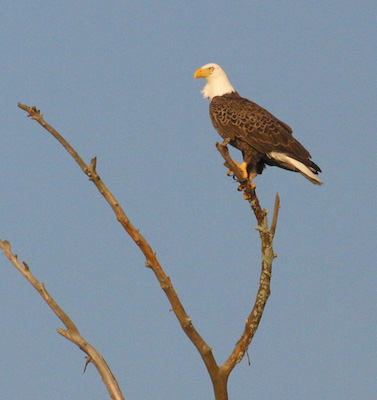Nesting in Georgia |
 |
| Early Fall: Nest Prep Eagles return to nesting territories. Nests can take from a few days to a few months to build. Some nests are re-used for years. |
| November-February: Eggs Laid Most often two eggs are laid per nest, though sometimes one or three. Typically, one egg is laid per day. Nesting along the coast can start and end as much as two months earlier than in north Georgia. |
| About 35 Days: Incubation Incubation begins when the first egg is laid. Although both parents incubate the eggs, the female plays a much greater role in this duty. |
| January-February: Hatching Hatching occurs over several days. The first hatchling is usually bigger because it’s one-two days older. |
| 8-12 Weeks: Rearing Young Parents shelter, feed and guard the eaglets for eight-12 weeks. By 10 weeks, the young are nearly the same size as the adults. They begin flapping their wings, hopping onto branches and trying short flights. |
| 11-14 Weeks: Fledging The young typically leave the nest, or fledge, from late March to early May (but as late as June in north Georgia). Fledglings remain in the general area of the nest and are fed by the parents for up to six weeks. |
| First Year: Dispersal Many first-year (juvenile) eagles leave the nest territory about four-six weeks after fledging. These dispersal movements may take the birds as far north as the Great Lakes, Hudson Bay or St. Lawrence seaway regions. In late summer or early fall, they return to the South, often to the vicinity of the nest where they fledged. |
DNR monitors bald eagle nests annually in Georgia and works with landowners to help protect the sites. Bald eagles have gradually recovered here and elsewhere in the U.S. after a population decline largely attributed to exposure to the pesticide DDT resulted in no known successful nests in Georgia from 1971-1980. The state's nesting eagle population has been increasing since, with new nesting territories established each year.
Nest Notes
- After a population decline largely attributed to exposure to the pesticide DDT that resulted in no known successful nests in Georgia from 1971-1980, bald eagles have gradually recovered in the state and elsewhere in the U.S.
- Bald eagle nests are big, generally 5-6 feet in diameter and 2-4 feet tall. Most In Georgia are built in mature, living pines – about 95 percent are in pines – and just below the upper canopy.
- Eagle pairs mate for life and often use the same nest for several years before rebuilding nearby. Often a mated pair will build an alternate nest near the primary nest.
- Usually nests are near reservoirs, rivers, a group of farm ponds, along the coast or near large wetlands such as marshes. Eagles eat fish, waterfowl (particularly coots during nesting season), other birds, turtles and other reptiles, small mammals, and carrion.
- DNR monitors nesting in January and February to determine occupancy and in March and April to estimate productivity. The surveys inform management and identify potential threats.
- Threats to eagles vary from the neurological disease vacuolar myelinopathy to being shot, hit by cars, electrocuted, injured by other eagles, preyed on (especially nestlings) by great horned owls and sickened and killed by eating poisoned rodents and deer carcasses containing lead bullets or fragments.
- Learn more about bald eagles, including how to identify them and their nests.
Identifying Bald Eagles
Bald eagles do not fully exhibit the distinctive white heads and tails or yellow bills and irises until 4-5 years old. During their first few years, the birds range in color from almost solid brown to brown with white blotches. Before age 5, bald eagles are usually called sub-adults or immatures.

Photo by Tom Wilson

Photo by Craig Koppie

Photo by Tom Wilson


Mistaken Identity
Golden eagles are occasionally seen in rural Georgia, almost always between mid-fall and late winter. While adult bald and golden eagles are easy to distinguish, immature bald eagles are often reported as golden eagles. One tip: Look for the golden head and nape in golden eagles of all ages, and the bright white patches at the base of the flight feathers and the tail in first-year birds. The legs (tarsi) of golden eagles are fully feathered; the legs of bald eagles are not.
Osprey nests are often misidentified as eagle nests. Like eagles, ospreys, another fish-eating species, often use the same nest year after year and the nests can become large. But ospreys usually nest at the very top of trees – usually dead ones – and on human-made structures such as wooden platforms, channel markers and cell and electrical towers. In flight, eagles tend to hold their wings flat and straight. Osprey wings are angled at the “wrist” and bowed from shoulder to tip.
Give Them Room
Stay at least 330 feet away from an active eagle nest. Getting closer violates federal guidelines and can disturb adults – keeping them from incubating eggs or feeding chicks – or cause the young to jump from the nest before they are ready to fledge.
It is not uncommon to see eaglets and other young raptors on the ground. Do not approach or try to handle them. Their parents are likely nearby.
For more information, including about guidelines and permits regarding eagle nests, contact DNR’s Wildlife Conservation Section office (478-994-1438) or Dr. Bob Sargent (bob.sargent@dnr.ga.gov).



















